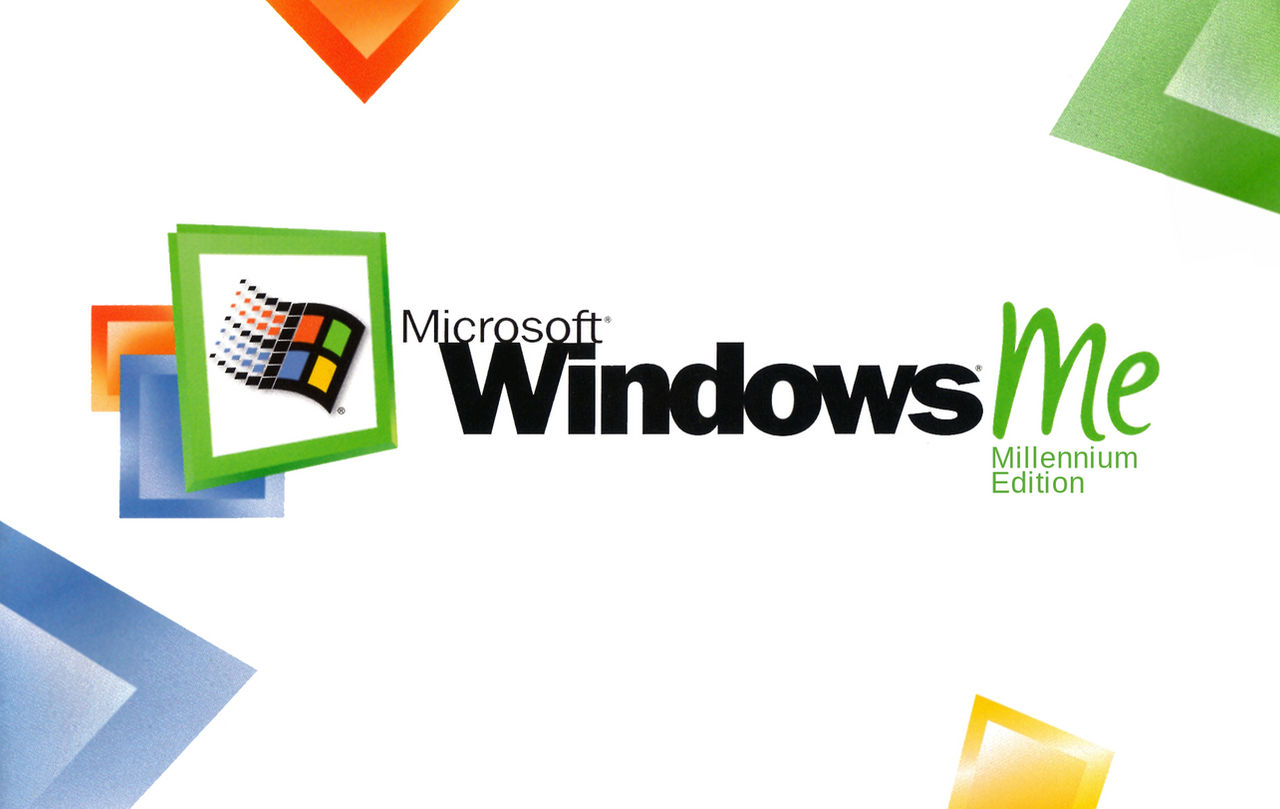Ah, Windows Me. The middle child of the 90s Windows trilogy (although it wasn’t actually released in the 90s), Windows Me doesn’t have the greatest reputation. Its detractors see it as a buggy, unstable mess, while even those who didn’t mind it don’t have much positive to say about it. The system launched in 2000, two years after Windows 98, and unlike that operating system, it wasn’t basically received positively at all; most derided it for being too flawed to run on many users’ computers. Here are 17 things you might not have known about Microsoft’s most hated operating system.
1. It’s Me, not ME
Although you might have seen it written as “Windows ME” from time to time, it’s actually Windows Me. It does stand for something – which we’ll get onto in a moment – but Microsoft also intended it to mean “Windows Me”, as in “for me”. This is because Microsoft pitched it as the first operating system designed specifically for the consumer and not necessarily with businesses in mind.
2. “Me” also stands for “Millennium Edition”
Windows Me was released in 2000, thus making it the “Millennium Edition” of Windows. Therefore, the name has a double meaning; the Me refers not only to the personal pronoun, but also to the system’s status as supposedly the definitive operating system for the millennium. For reasons we’ll get into later, that now seems like an impossibly optimistic assessment of Windows Me’s chances, but you can’t fault Microsoft for its positive outlook, at least.
3. Windows Me was panned
Despite a cautious, initially positive reception, it didn’t take long for the critics and the users to turn against Windows Me. It was universally hated, mostly because its users said it was so buggy and annoying to use that it got in the way of productivity tasks and basic daily browsing. Naturally, this is not what Microsoft wanted to hear, which is why Windows Me ended up “enjoying” such a short shelf life.
4. Microsoft ended support for Me in the same year as Windows 98
Microsoft supported most of its operating systems for a period of about five to six years, and despite the horrible reception for Me, this was the case for that much-maligned operating system as well. Support for Windows Me ended in 2006, which was the same year that Microsoft stopped supporting Windows 98. Obviously, though, Windows 98 had a two-year head start, which should tell you something about the popularity of Windows Me at the time.
5. The pitch for Windows Me was a “multimedia centre”
Visiting the original Microsoft Windows Me site, you can see (in all its early-2000s glory) that it proposes to turn your computer into a home entertainment centre and media hub with Windows Me. This is because of the advent of Windows Media Player 7 and Windows Movie Maker, the latter of which was introduced for the first time alongside Windows Me. Windows Movie Maker is still being used today, but it’s not a particularly popular piece of software, especially when considering some of the free alternatives widely available on the market.
6. System Restore appeared for the first time on Windows Me…
Over in Windows 2000, which was Microsoft’s business-oriented operating system, a feature called System Restore had been introduced. This allowed users experiencing a Windows error to roll back their systems to a point where they knew everything was working properly, letting them troubleshoot what could have caused the error. Windows Me also included this feature, and given how much of a disaster it turned out to be, that’s probably for the best.
7. …but it would restore viruses too
Hilariously (although not for the user undergoing the process), if you had a virus at the time you created a System Restore backup snapshot, then the System Restore process would restore the virus alongside the contents of your system. This would happen even if you’d managed to eradicate the virus, which is, to say the least, not ideal in terms of user satisfaction.
8. A fresh copy of Windows Me cost $210
If you were buying a brand new copy of Windows Me, and not upgrading from a previous version of Windows, then it would have set you back around $210. The upgrade version was $100 cheaper at $110, but still, that’s a lot of money to pay. As the operating system’s bad reputation picked up steam, Microsoft felt the need to start discounting Windows Me, chopping the price in the hope that consumers would start buying the system. They didn’t, and it would be discontinued shortly afterwards.
9. Windows Me earned some derisive nicknames
If you were around during the Windows Me days, then you’ll probably remember some of the nicknames the operating system garnered. The most devastating and memorable one was probably “Windows Mistake Edition”, which consumers began to call Me after it started exhibiting all of the issues that would eventually lead to its demise. When the public is coming up with brutal nicknames for your software like that, you know you’ve got some problems.
10. Windows Me was rushed out
In order to ensure that consumers had a millennium-themed Windows operating system to match the one Microsoft had released to businesses earlier that year (Windows 2000), the Redmond company rushed the release of Windows Me to ensure it hit shelves in time for Christmas. The fact that the system was rushed was immediately obvious to anybody who had interacted with it; using Windows Me was just as unsatisfying and miserable as public opinion says it was.
11. Windows Me removed real-mode DOS support
Here’s a quick technical primer. Real-mode DOS essentially refers to the version of DOS that most applications, games, and other DOS-using systems would look to when they needed to complete a process. One of Windows Me’s many sins was removing support for real-mode DOS, which made the operating system boot up quicker but also rendered many users’ programs completely invalid. Microsoft giveth with one hand and taketh away with the other.
12. Windows Me wasn’t the only unstable OS
Despite Windows Me having a (well-deserved) reputation for instability, it was far from the only unstable OS in the Windows canon. In fact, Windows 95 and Windows 98 had both been criticised for being unstable, buggy, and prone to crashing; it’s just that they offset these issues with their own advantages, and Microsoft released updates intended to address these issues. No such updates were forthcoming for Windows Me, however.
13. No service packs were released for Windows Me
Unlike other Windows iterations, Microsoft saw fit to release precisely zero service packs for the Windows Me ecosystem, a trick it would repeat for Windows 10 (albeit for different reasons). This was probably for the best; the operating system was crashing and burning, and Microsoft made a very logical decision to abandon ship and create something new instead. However, Windows Me users who liked the operating system but wished it was more stable were left completely in the lurch by this decision.
14. The Blue Screen of Death went mainstream thanks to Windows Me
The Blue Screen of Death is what many users called the infamous crashing screen they would encounter when Windows bumped into a fatal error. It had been present in both Windows 95 and 98, but for the most part, the vast majority of users wouldn’t have cause to see it more than a handful of times. In Windows Me, however, the system crashed so often that the BSOD essentially became desktop wallpaper for many users, thus popularising the term.
15. Automatic updates debuted in Windows Me
After a basic version of Windows Update debuted in Windows 98, Windows Me further refined the concept by introducing automatic updates. Your system could now find updates you needed and download and install them transparently without you needing to search for them yourself. This was a very efficient system, and the fact that it arrived on one of the buggiest operating systems of all time meant that it was timely and appreciated too.
16. Hibernation was also a first-time feature in Windows Me
Technically, the Hibernate feature was included in Windows 2000 at the operating system level, but since Windows Me was a consumer-oriented version of Windows 2000, we’ll call it the first commercially available operating system to feature this technology. You could now tell your PC to go to sleep, and it would do so, booting back up into the same state in which you left it without the need to re-open programs.
17. Microsoft released a new Windows just one year after Me
Windows Me was so universally reviled that Microsoft felt the need to immediately release a new Windows system to rectify the problem. Windows XP arrived in 2001, with the XP standing for “eXPerience”; this was a genuinely new, improved, and revamped version of Windows. Despite receiving some negative backlash for its colourful aesthetic at the time, Windows XP has endured in popularity since its launch, while Me certainly has not.
– Continue Reading This Article Series
17 Things You Didn’t Know About Windows:
– Windows 3.0x
– Windows 95
– Windows 98
– Windows Me
– Windows Vista
– Windows XP
– Windows 7
– Windows 8
– Windows 10
– Windows 11

